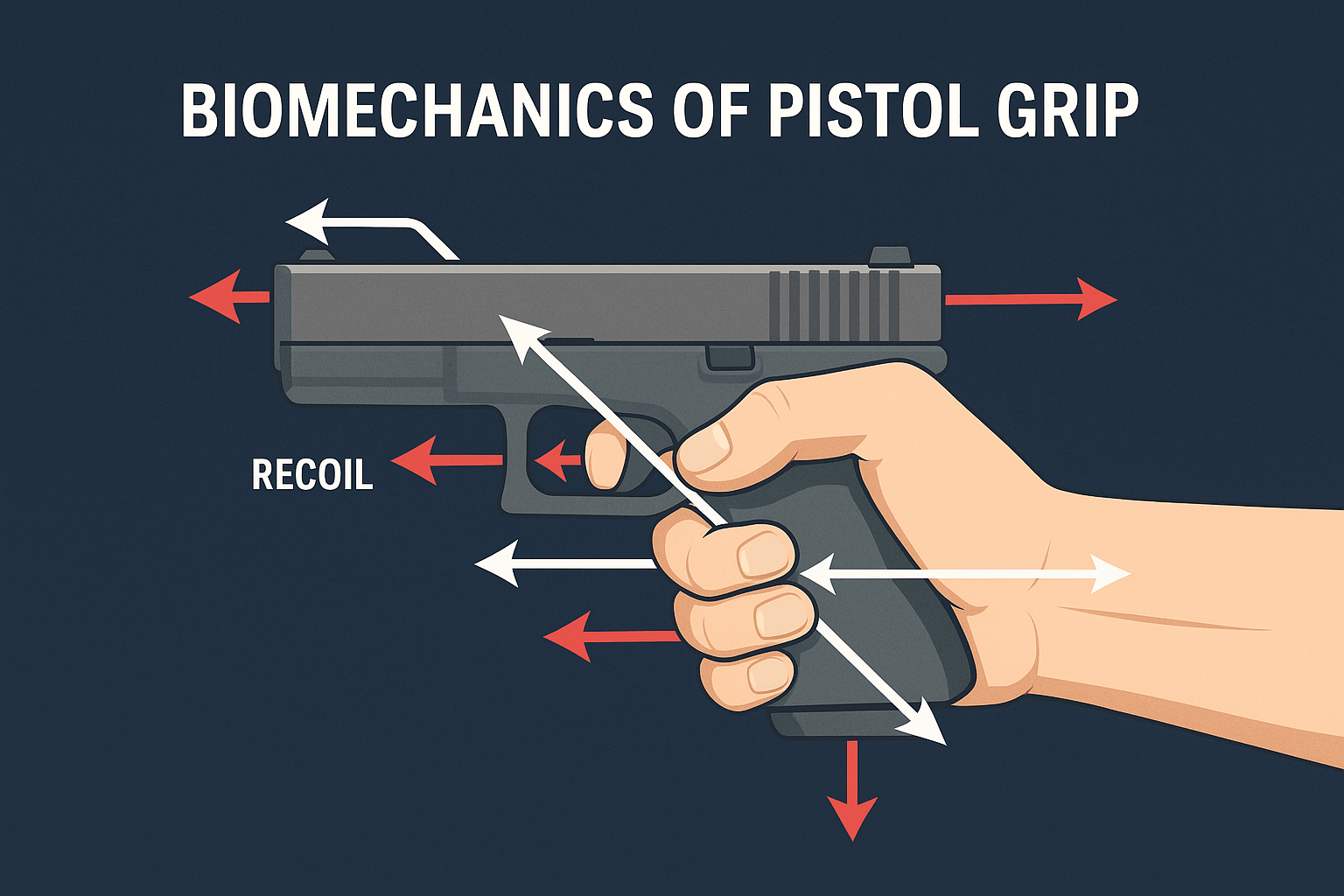The Biomechanical and Kinetic Analysis of Two-Handed Pistol Grip Efficiency
Abstract
This paper examines the anatomical, physiological, and mechanical foundations of effective pistol grip in the context of both sport marksmanship and defensive firearm use. Traditional methods rely on opposing horizontal isometric tension between the dominant and support hands. However, contemporary biomechanical research supports an optimized technique: directing vector forces from each hand toward the epicenter of ballistic combustion—the interface between the barrel and the slide—thus aligning applied muscular force with the firearm’s mechanical recoil pathway. This model integrates musculoskeletal leverage, neuromuscular efficiency, and the physics of reciprocating mass to achieve stability, recoil mitigation, and accuracy retention under dynamic conditions.
1. Introduction
The human upper limb, comprising approximately 54 articulating joints and a complex array of synergistic musculature, is the biological mechanism through which fine firearm control is executed. Marksmanship performance depends not solely on strength but on the integration of skeletal alignment, neuromuscular control, and mechanical resonance management.
In the traditional doctrine of firearms instruction, grip has been understood as the act of applying opposing lateral pressures between the dominant and support hands. This creates stability but fails to align muscular force vectors with the firearm’s actual mechanical movement under recoil. Modern analysis reframes the grip as a three-dimensional biomechanical vise, capable of absorbing and redirecting forces across six planes of resistance, optimizing kinetic energy transfer through the upper kinetic chain (hand → wrist → forearm → humerus → scapula → axial skeleton).
2. Purpose of Grip from a Biomechanical Perspective
The grip fulfills four interdependent biomechanical functions:
- Control of Angular Momentum — Mitigating muzzle rise by limiting the torque around the hand–pistol interface.
- Maintenance of Sight Alignment — Ensuring rapid visual reacquisition through repeatable skeletal positioning.
- Energy Dissipation — Distributing recoil impulse through bone and connective tissue rather than small motor units.
- Sensorimotor Calibration — Allowing proprioceptive feedback for consistent neuromuscular response during successive shots.
3. Skeletal and Muscular Engagement
Effective grip mechanics employ:
- Thenar and hypothenar eminences for anterior–posterior compression.
- Flexor carpi radialis, flexor digitorum profundus, and pronator teres for sustained isometric control.
- Extensor carpi radialis longus and brachioradialis for recoil damping and wrist locking.
- Scapular retraction via the rhomboids and trapezius to stabilize the shoulder girdle.
The skeletal support originates in a high tang grip, aligning the radius and ulna directly behind the slide’s reciprocating axis, minimizing torque generation and ensuring linear energy transmission through the forearm bones.
4. Updated Grip Vector Model: Directing Force Toward the Epicenter of Explosion
The updated kinetic model shifts the orientation of applied pressure:
- The dominant (trigger) hand exerts forward and slightly upward pressure directed along a vector terminating at the junction between the barrel and the slide (the firearm’s ballistic epicenter).
- The support (control) hand exerts counter-pressure upward and inward toward the same focal point, originating from the base of the trigger guard and palm heel.
This redirection of force vectors opposes the rearward and upward momentum produced by cartridge detonation, converting linear recoil into distributed load paths absorbed through skeletal alignment rather than muscular compensation. This results in:
- Reduced muzzle climb through opposing vector convergence.
- Faster sight recovery as the firearm’s mass returns to equilibrium without lateral drift.
- Decreased cumulative fatigue, as energy dispersion follows the natural load-bearing structure of the upper limbs.
5. Six-Axis Stabilization: Treating the Firearm as a Three-Dimensional Object
To understand the firearm as a six-sided kinetic system, one must apply opposing biomechanical constraints in all axes:
- Superior–Inferior: Vertical stabilization by wrist locking and counter-tension through forearm extensors and flexors.
- Medial–Lateral: Inward compression (“clamshell” effect) generating side-to-side constraint and frictional stability.
- Anterior–Posterior: Push–pull tension (nutcracker effect) establishing longitudinal control along the recoil vector.
This configuration transforms the hands into a biomechanical vise, exerting balanced compressive force across all six opposing planes, thereby minimizing translational and rotational displacement during the firing cycle.
6. Dynamic Recoil Load Transfer and Recoil Spring Biomechanics
During firing, combustion gases generate rapid chamber pressure (≈20,000–35,000 psi) propelling the bullet forward while initiating equal and opposite momentum through the slide assembly. The slide’s reciprocating mass undergoes a brief rearward acceleration, compressing the recoil spring—a helical elastic medium storing potential energy.
The load transfer sequence can be described as follows:
- Phase I: Combustion Impulse — Instantaneous rearward acceleration transmitted to the shooter’s hand via the bore axis.
- Phase II: Spring Compression — Elastic potential energy stored as the recoil spring shortens, temporarily decoupling slide momentum from frame inertia.
- Phase III: Restorative Phase — Spring decompression propels the slide forward, returning the system to equilibrium.
The shooter’s grip must counter these rapid oscillations through isometric stabilization, enabling the upper kinetic chain to act as a dynamic shock absorber, maintaining muzzle alignment and facilitating rapid return of sights to the target plane.
7. Load Path and Weight Transfer Through the Upper Kinetic Chain
Upon detonation, the recoil impulse transfers through sequential biomechanical segments:
- Metacarpal interface → radius/ulna articulation → humeroulnar joint (olecranon locking) → scapular anchor → spinal base.
This linear pathway converts ballistic impulse into distributed joint load, minimizing localized strain and preventing chronic overuse syndromes. Proper alignment ensures that kinetic forces remain collinear with skeletal architecture, preserving both structural integrity and neuromuscular endurance.
8. Neuromuscular Adaptation and Proprioceptive Calibration
With repetition, the cerebellum encodes the precise degree of isometric tension and joint angle coordination required for recoil management. This adaptation manifests as kinaesthetic mapping, enabling the shooter to re-align sights subconsciously (“alignment by feel”) even under elevated sympathetic arousal.
Electromyographic (EMG) studies suggest that consistent training reduces co-contraction variance among forearm flexors/extensors by up to 25%, resulting in smoother recoil absorption and faster target reacquisition.
9. Injury Prevention and Biomechanical Sustainability
Incorrect grip orientation or excessive lateral torque induces repetitive stress on the carpal tunnel, pronator teres, and extensor retinaculum. Conversely, alignment along the recoil vector dissipates impulse through bone structure, reducing risk of:
- Medial epicondylitis (golfer’s elbow)
- Wrist tendinopathy
- Glenohumeral impingement due to reactive shoulder tension
Skeletal-vector alignment thus not only enhances performance but ensures long-term musculoskeletal health for high-volume shooters.
10. Conclusion
The evolution of pistol grip methodology—from traditional lateral opposition to force convergence upon the ballistic epicenter—represents a paradigm shift in firearms biomechanics. Treating the pistol as a six-axis object and directing opposing force vectors through its geometric center enables the shooter to integrate anatomy with physics. By aligning the musculoskeletal system with the firearm’s internal recoil dynamics, the practitioner achieves maximal efficiency, minimized muzzle deviation, faster sight recovery, and reduced fatigue.
Future research employing high-speed motion capture and EMG analysis may further quantify the load distribution and micro-tremor suppression achieved by this updated grip vector methodology, validating its superiority in both competitive and defensive shooting environments.
References
Copay, A. G., & Charles, M. T. (2001). The influence of grip strength on handgun marksmanship in basic law-enforcement training. Policing: An International Journal, 24(1), 32–39.
Lin, J.-H., Radwin, R. G., & Richard, T. G. (2001). A dynamic biomechanical model of the hand and arm in pistol grip power hand tool use. Ergonomics, 44(3), 295–312.
Marković, S., Dopsaj, M., Umek, A., Prebeg, G., & Kos, A. (2020). The relationship of pistol movement measured by a kinematic sensor, shooting performance and handgrip strength. International Journal of Performance Analysis in Sport, 20(6), 967–980.
Mon-López, D., Gómez, M. Á., & Lorenzo, A. (2019). The relationship between pistol Olympic shooting performance and peak finger flexor and shoulder abduction forces relative to BMI. PLOS ONE, 14(9), e0220790.
Muirhead, H., Jankovic, N., Ruddock, A., & Meir, R. (2019). The relationship between fitness and marksmanship in law-enforcement recruits. Safety, 5(3), 54.
Olsson, E., Tinnsten, M., & Jonsson, M. (2021). Key technical components for air pistol shooting performance. International Journal of Performance Analysis in Sport, 21(3), 403–417.
Simo, V. (2023). Biomechanics of firearm recoil in shooting incidents. Journal of Forensic Biomechanics, 14(6), 464.
Smith, J. R. (1991). An investigation of the ergonomics and biomechanics of rifle shooting [Master’s thesis, University of Cape Town]. University of Cape Town Open Access Repository. https://open.uct.ac.za/items/3a36eb12-a3de-4d55-841e-54ef3f6d254c






